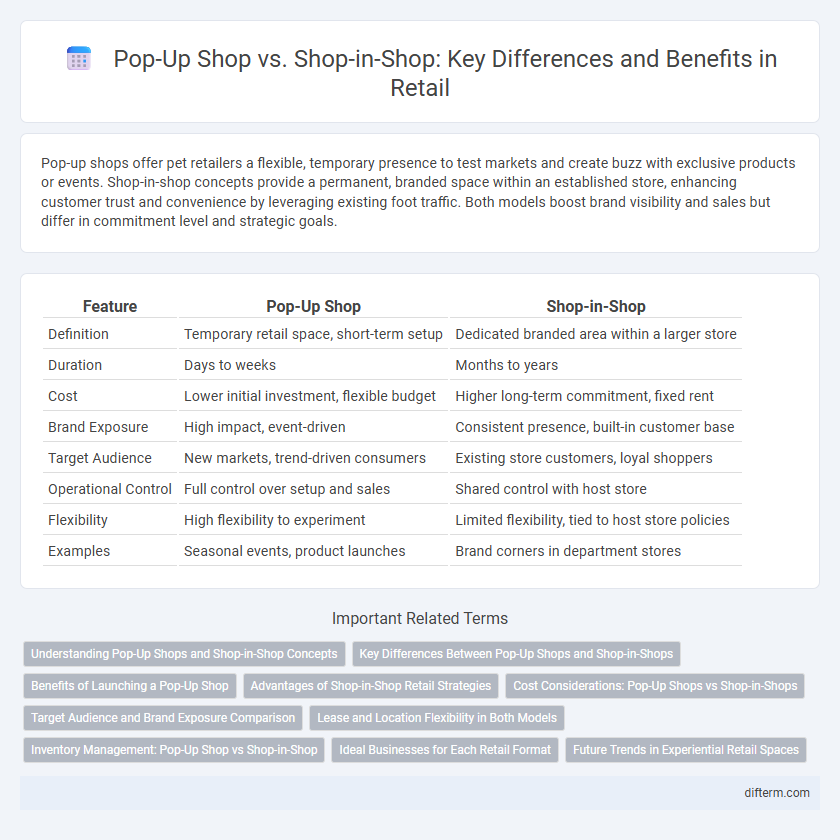Pop-up shops offer pet retailers a flexible, temporary presence to test markets and create buzz with exclusive products or events. Shop-in-shop concepts provide a permanent, branded space within an established store, enhancing customer trust and convenience by leveraging existing foot traffic. Both models boost brand visibility and sales but differ in commitment level and strategic goals.
Table of Comparison
| Feature | Pop-Up Shop | Shop-in-Shop |
|---|---|---|
| Definition | Temporary retail space, short-term setup | Dedicated branded area within a larger store |
| Duration | Days to weeks | Months to years |
| Cost | Lower initial investment, flexible budget | Higher long-term commitment, fixed rent |
| Brand Exposure | High impact, event-driven | Consistent presence, built-in customer base |
| Target Audience | New markets, trend-driven consumers | Existing store customers, loyal shoppers |
| Operational Control | Full control over setup and sales | Shared control with host store |
| Flexibility | High flexibility to experiment | Limited flexibility, tied to host store policies |
| Examples | Seasonal events, product launches | Brand corners in department stores |
Understanding Pop-Up Shops and Shop-in-Shop Concepts
Pop-up shops are temporary retail spaces designed to create buzz, test new markets, or clear inventory, often occupying vacant locations for a limited time to attract foot traffic and provide unique shopping experiences. Shop-in-shop concepts embed a branded area within an existing retail store, offering consistent brand presence and product immersion while leveraging the host store's established customer base. Both strategies optimize retail space usage and drive sales through targeted, experiential marketing tailored to specific consumer segments.
Key Differences Between Pop-Up Shops and Shop-in-Shops
Pop-up shops operate as temporary retail spaces, allowing brands to create immersive, short-term experiences that drive immediate customer engagement and test new markets with low investment. Shop-in-shops function as designated sections within existing stores, providing a semi-permanent presence that leverages the host retailer's foot traffic and infrastructure to build brand awareness and foster long-term customer relationships. Key differences include duration--pop-up shops are transient, while shop-in-shops offer extended exposure--and operational control, where pop-up brands manage the entire storefront versus partial control in shop-in-shops.
Benefits of Launching a Pop-Up Shop
Launching a pop-up shop provides brands with a flexible, low-cost way to test new markets and engage directly with customers in high-traffic locations. Pop-up shops generate immediate buzz and create immersive brand experiences that boost customer loyalty and drive sales without long-term lease commitments. Retailers benefit from real-time feedback and data collection, allowing them to refine their offerings and marketing strategies efficiently.
Advantages of Shop-in-Shop Retail Strategies
Shop-in-shop retail strategies offer enhanced brand visibility by integrating a dedicated branded space within an established retailer, fostering direct customer engagement and trust. This approach reduces overhead costs compared to standalone stores while leveraging the host retailer's foot traffic, leading to higher sales conversion rates. Merchants gain valuable consumer insights through real-time interactions, enabling targeted marketing and inventory optimization.
Cost Considerations: Pop-Up Shops vs Shop-in-Shops
Pop-up shops typically incur lower upfront costs due to short-term leases and minimal design requirements, making them ideal for budget-conscious retailers testing new markets. Shop-in-shops demand higher investment in branding and integration within an existing store, resulting in longer-term financial commitments but greater brand visibility. Evaluating rental fees, staffing expenses, and promotional budgets is crucial when comparing cost efficiencies between these retail formats.
Target Audience and Brand Exposure Comparison
Pop-up shops attract a dynamic, experience-seeking target audience looking for novelty and limited-time offers, creating high brand exposure through urgency and exclusivity. Shop-in-shop formats cater to loyal customers of the host store by seamlessly integrating brand presence, fostering trust and repeated engagement. Both strategies enhance brand visibility, but pop-up shops generate spike-driven, event-focused exposure, while shop-in-shops build sustained brand awareness within an established retail environment.
Lease and Location Flexibility in Both Models
Pop-up shops offer short-term lease agreements and high location flexibility, allowing retailers to quickly test markets or seasonal trends without long-term commitments. Shop-in-shop models typically involve longer leases within established stores, providing stable presence but less mobility in geographic location. Both models enable brands to enhance physical footprint, but pop-up shops prioritize agile location changes while shop-in-shops focus on embedded customer access inside anchor stores.
Inventory Management: Pop-Up Shop vs Shop-in-Shop
Inventory management in pop-up shops demands agile, short-term stock planning due to limited space and temporary setups, often relying on real-time sales data to adjust orders quickly. Shop-in-shop formats benefit from integrated inventory systems with the host retailer, enabling smoother stock replenishment and better visibility across multiple locations. Efficient inventory control in both models is crucial to minimize stockouts and overstock, but shop-in-shop setups typically achieve higher accuracy through shared logistics and centralized management.
Ideal Businesses for Each Retail Format
Pop-up shops are ideal for seasonal brands and startups seeking to create buzz and test new markets with minimal investment and short-term commitments. Shop-in-shop formats suit established retailers and product lines that aim to enhance brand presence within high-traffic department stores or malls, leveraging existing footfall and customer trust. Fashion labels, tech gadgets, and beauty products often benefit from shop-in-shop setups to provide immersive brand experiences while sharing operational costs.
Future Trends in Experiential Retail Spaces
Pop-up shops offer agile, short-term retail activation, allowing brands to test markets and create immersive customer experiences with minimal investment. Shop-in-shop models provide deeper brand immersion within established stores, leveraging existing foot traffic and fostering long-term customer engagement. Emerging trends emphasize integrating advanced AR/VR technologies and personalized digital touchpoints to enhance interactivity and data-driven customer insights in both formats.
pop-up shop vs shop-in-shop Infographic

 difterm.com
difterm.com